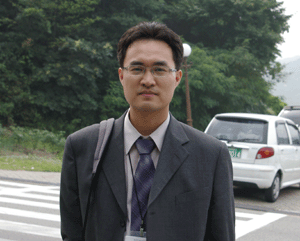파워엘리트 장학생 인터뷰

- 파워엘리트 장학을 알게 된 경로와 파워엘리트 장학생으로 선발된 소감은.
= 우선 부족한 저를 파워엘리트 1기 장학생으로 선발해주신 우리학교의 모든 관계자 여러분과 제가 열정을 가지고 전자공학을 전공하도록 늘 배려해주신 전자공학과 여러 은사님들께 감사드린다.
미국 유학에 뜻을 두고 공부하고 있던 중에, 이를 알고 계시던 은사님께서 직접 연락해 알려주셔서 파워엘리트 장학 프로그램을 알게 되었다.
- 파워엘리트 장학을 준비하는 과정은.
= 미국의 대학원에 진학하기 위해서 필요한 공식적인 시험은 TOEFL과 GRE이다. 이 두 가지 시험은 어학능력에 중점을 두고 만들어진 것이므로 평소 어휘를 중심으로 어학능력을 꾸준히 배양하는 것이 좋다.
또한 GRE 성적은 작문시험 성적이 나쁜 경우 입학사정에서 매우 불리해지기 때문에 문제 풀이 위주의 공부보다는 이를 대비한 꾸준한 연습이 필요한 것 같다.
무엇보다도 파워엘리트 장학을 지원 받을 수 있는 미국 상위 5위권 내 대학원에 진학하기 위해서는 TOEFL과 GRE성적이 우수해야 할 뿐만 아니라 GPA(학점)와 교수님의 추천서가 더욱 중요한 요소로 작용한다. 전공에 열정을 가지고 학위과정 전반에 걸친 꾸준한 노력이 가장 중요하다.
파워엘리트 장학 선발과정은 1차 서류 전형과 2차 전공면접 3차 최종면접으로 진행된다. 전공면접은 전공교수님께서 영어 및 전공 관련 면접을 보고 최종면접은 진학 후 계획, 어학 관련한 면접을 본다. 이와 관련해 개인적으로 준비를 하는 것이 좋다.
- 파워엘리트 장학을 준비하는데 어려웠던 점은.
= 직장을 다니면서 준비했기 때문에 학업과 직장업무를 병행해야 했던 것이 가장 어려웠던 점이었다. 그러나 한편으로는 이러한 특수한 여건이 오히려 자신을 잘 관리하는 데 채찍이 되었다고 생각한다.
- 파워엘리트 장학의 문제점과 개선해야 할 점은.
= 파워엘리트 장학프로그램이 이번에 처음으로 시행되는 것이지만 학교 차원에서 지속적인 관심을 가지고 추진해온 사업이라서 특별히 문제점이라고 생각되는 부분은 없다. 다만, 이러한 장학 사업이 학교 밖으로 널리 홍보가 되어서 향후 유학을 준비하는 우리학교 후배들뿐만 아니라 대학 진학을 앞둔 예비 동국인들까지 확신과 신념을 가지고 미래를 준비 할 수 있도록 해주었으면 한다.
덧붙여서 파워엘리트 장학생이 입학하게 되는 학교의 재정지원(RA, TA, fellow ship 등)에 따른 파워엘리트 장학금의 수혜 범위와 관련하여 여러 가지 시행착오가 발생할 수 있다. 이러한 시행착오는 현재 가장 권위 있는 삼성 이건희 장학 재단, 한국고등교육재단(KFAS), 관정 이종환 교육재단 등에서 지난 수년간 운영하고 있는 국외 유학 장학프로그램의 재정지원자에 대한 장학재단의 수혜규정을 참고하여 이를 수용하면 시행착오를 줄이고 발생할 수 있는 문제점도 많이 해소가 될 것 이다.
- 파워엘리트 장학을 준비하는 학생들이 참고해야 할 점은.
= 해외대학으로 유학을 가기 위해서는 생각보다 상당한 기간과 노력을 투자해야 한다. 따라서 철저한 계획이 무엇보다도 중요하다고 생각한다. 미국 대학원의 경우 TOEFL, GRE 성적이 필요하고 학교 및 전공에 따라 GRE subject 성적도 필요하다. 또한 학교마다 다르지만 일반적으로 3인 이상의 추천서, Statement of Purpose(연구계획서), 이력서(연구경력기재), 성적표, 졸업증명서 등이 요구된다. 본인의 우수성을 증명할 수 있는 기타 서류도 첨부하면 된다.
- 앞으로의 각오는.
= 모교의 따뜻한 지원으로 새로운 도전에 임하게 되었다. 미국에서의 유학 생활이 내 인생의 ‘동안거(冬安居)’라고 생각한다. 이 기간 동안 최선을 다해서 용맹정진하여 모교를 빛내는 동국인이 되고자 노력할 것이다.

